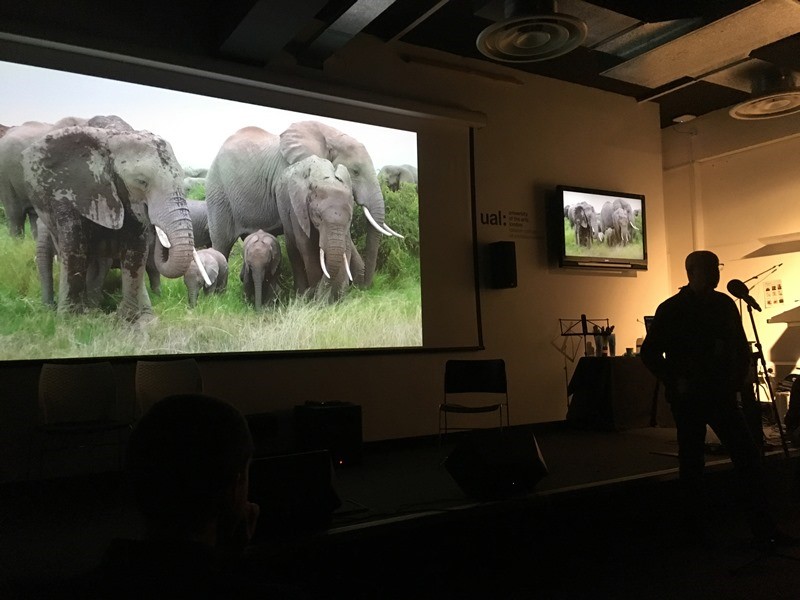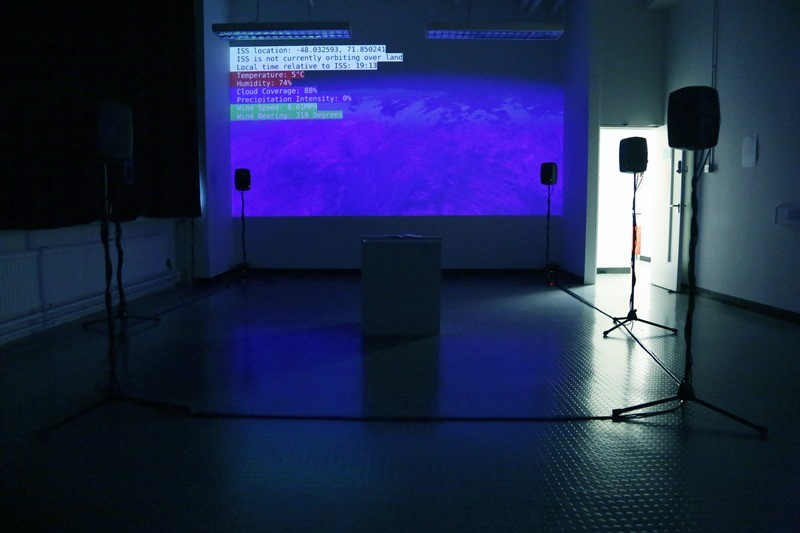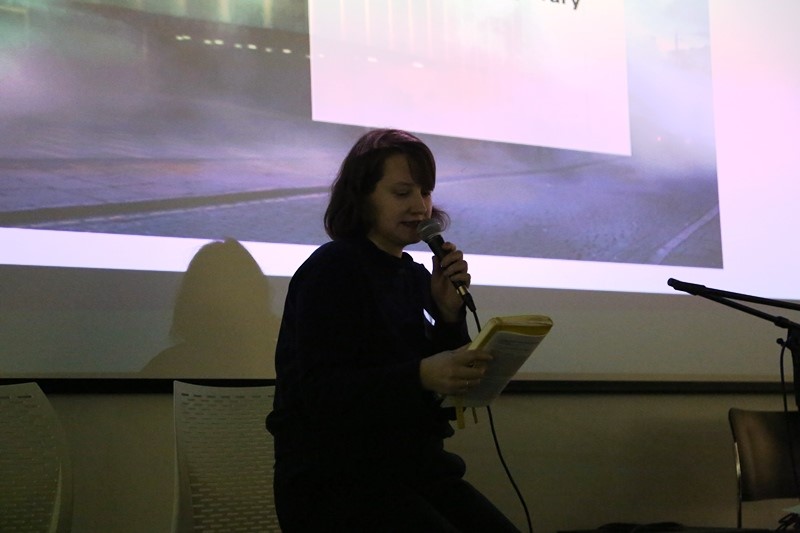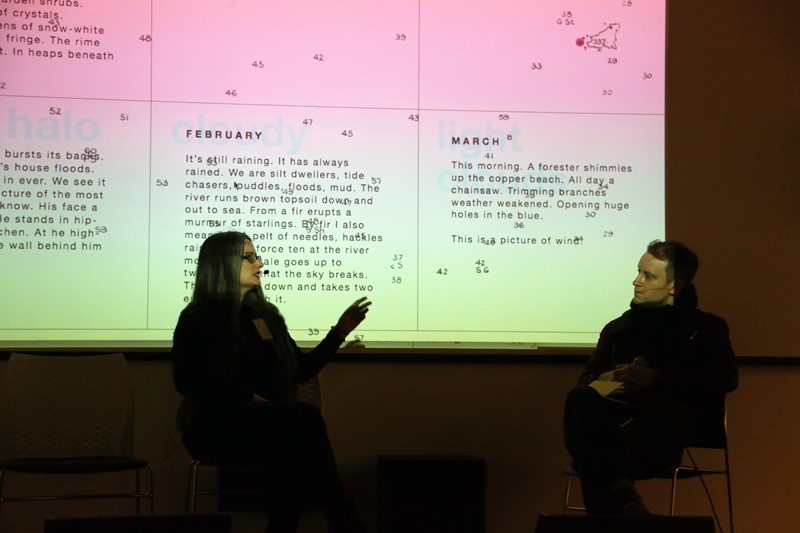Home » For and about students » Training and support » Records of TECHNE Events » Student Led Events » Large Objects Moving Air 2018
Large Objects Moving Air 2018
TECHNE funded, Co authored by Matt Parker and Jennifer Lucy Allan, PhD Researchers at UAL Research Centre for Creative Research into Sound Art Practice (CRiSAP), London College of Communication (LCC)
Image 1 Keynote Speaker JR Carpenter in discussion with Mark Peter Wright (Photo c/o Tim Smith)
Tips on running a conference: Large Objects Moving Air 2018
What links Internet infrastructures and foghorns? This is not a trick question.
Back in May 2017, we (Matt Parker and Jennifer Lucy Allan) found the answer: Large Objects Moving Air (LOMA). Both of us are TECHNE-funded students based in CRiSAP at LCC. Matt researches listening as an art practice and its application to the study of Internet infrastructures and Jen is writing a social and cultural history of the sound of the foghorn.
The name stuck, and we realised as a concept that it brought together more topics than just our interests. Air is everywhere and nowhere. What comes to mind when one thinks about air? It is a carrier of frequencies, energies, vibrations, toxins, pollutants and blast waves. It supports life and is a site of communication. It is clouds and The Cloud. Who owns it? Can it be owned? Who or what are the agents in the transmission and circulation of air? How does it circulate and what circulates within it? It encompassed ideas around The Cloud, media materiality, industrial machines and air conditioning units, military air space, political speech, weather, clouds, radio transmission. The theme began as something diffuse, but became a way to understand interdisciplinarity, to test the possibilities for cross-disciplinary conversation.
We applied for funding from the TECHNE Arts and Humanities Research Council consortium which supports both of our PhDs, forming an organising committee from across TECHNE institutions. In addition we requested further funding through the LCC Graduate School and the UAL Postgraduate Community Project fund. All funding applications were successful. This was the easy part.

Image 2 Guest Speaker Chris Watson with elephants (Photo c/o Tim Smith)
Organising a conference is exhausting, exciting, time consuming, frustrating and, if everything goes well enough on the day, incredibly fulfilling. Many people across many sectors organise conferences every day, and for nine months, we joined them, along with our organising committee (Kate Fahey, Tim Smith, Benjamin Bland and Megan Archer). But instead of continuing to describe what a conference is, from here we’ll explain some of the challenges, hurdles, breakthroughs and rewards we faced.
The first thing for us to note is that our one-day conference grew bigger than we had expected. Our final headcount was around 130 people, with around 35 participants, which included 18 paper presentations, one art commission, one performance, and one guest sound lecture. We had started out with a small one-day conference, which we allowed to grow into a major international interdisciplinary conference. On the day itself, everything worked out well and feedback was overwhelmingly positive.
However, organising LOMA was not without its problems. Finding a venue and sorting appropriate rooms was difficult. This was made particularly challenging by our decision to try and expand the conference’s scale after we realised how popular it might become. We hoped for extra space to facilitate artwork and speakers alike and as our aspirations for the conference grew, availability of space within the college became increasingly limited, understandably, as other exhibitions and lecture bookings came in. LCC has a relatively low number of easily accessible spaces that work for an open invite conference, particularly when your conference takes place on the first day of a new term and in between exhibitions. Compromise was essential and the support of the research department at CRiSAP helped see us through to a suitable configuration.
Calls for papers and artworks came in a rush in the final few days before submissions closed: 30 paper proposals and 84 artwork proposals (for one paid commission we were still struggling to find a home for). The response was overwhelming, representing academics, artists and postgraduate researchers, who ranged in experience, from the arts and humanities and beyond. [Here we would like to take a moment to thank everyone who sent in proposals.] As a committee, we assessed each application over multiple sessions, and sent individual feedback to all who weren’t successful. Proposals take time, and we felt it was important to honor application time with a proper response.

Image 3 James Dooley LOMA Commissioned Artwork “Have you talked about the weather today?” Photo c/o Tim Smith

Image 4 CRiSAP Research Student Irene Revell Chairing a panel on Clouds and particles (Photo c/o Tim Smith)
Some key tips. One: book everything logistical as early as possible: rooms, estates teams, security. Two: Get the AV right. Draw up proper backline early, and make sure you know what everyone is bringing if they plan on presenting more than a PowerPoint. The AV team from the Sound Arts department at LCC were incredible, were so focused on detail, working for days before the conference sourcing equipment and setting up the rooms, and were a major part of what made the day run so smoothly. Three: Get the catering right – you can’t expect people to listen and engage without being properly fed and watered. Don’t forget about dietary requirements. Four: Make people feel welcome, before they arrive. Providing people with as much information as possible about locations, directions, sound checks, and accessibility and other details calms nervous presenters, and alleviates extra work on the day. Five: make sure everyone gets paid, from your artists to catering. This is easier said than done. The complex mesh of funding we accrued, kindly through Amanda Windle and Megan St Clair Morgan at the LCC Graduate School, Rachael Daniels from the UAL Postgraduate Community,, Carol Hughes and Jane Gawthorpe at TECHNE, and Lisa, Cathy and Angus at CRiSAP meant detailed budgeting with restrictions on what money could be used for, but it is manageable. Make a spreadsheet! Six: How are you documenting proceedings? Finally: don’t forget about the WiFi password.
If you plan to run a conference, don’t expect to see everything. You will be corralling people to soundchecks, making sure the AV team have eaten, checking the front desk, doing last minute signage, welcoming guests, and hopefully, seeing some papers. You will be thinking about what is happening next: Is everything running smoothly? How much time do people take to set up? Are we on time? Does anyone need anything? Is everyone happy? Is that dongle for an old MacBook going to connect to the projector? Is the screen saver setting switched off? (It wasn’t). Pay attention to details, so that the presentations can really shine, and don’t forget to document: Tim Smith from our team invisibly and expertly organised and managed all documentation, catching sound and pictures from each panel.
The final success, after an invigorating keynote by JR Carpenter, James Dooley’s commissioned installation Have you talked about then weather today? ongoing throughout the day, 18 amazing papers on topics that ran from meteorology to Marconi; from electrical storms to the people’s microphone, and from clouds in contemporary art to The Cloud, followed by a sound lecture/performance/presentation by BAFTA award winning sound recordist Chris Watson and Tony Myatt on elephant infrasound communication, was a musical endnote. We commissioned musician Laura Cannell to perform a piece for bass recorder as our ‘closing note’ for the conference. This striking piece, which represented a large object moving air and highlighted the importance of sound and the sensory within the conference, was a beautiful and moving way to end proceedings, and was definitely an idea to be repeated.
Background
Large Objects Moving Air was a student led conference organised by Matt Parker and Jennifer Lucy Allan; two PhD research students based at London College for Communication’s Creative Research into Sound Art Practice (CRiSAP) research centre. The conference received huge amount of organisational support from CRiSAP’s research administrator Lisa Hall and co-director Professor Cathy Lane along with a mass of support from the Screen School technicians Pär Carlsson, Seb Bruen, Paul Richardson, Simon Smith and Ian Collison. The conference committee was led by Matt and Jen, with Tim Smith and Kate Fahey; both PhD students at LCC, as well as Benjamin Bland (Royal Holloway) and Megan Archer (University of Brighton) as part of TECHNE, the AHRC research consortium they are each affiliated with.
Funding LOMA
Funding for the conference was received through the TECHNE AHRC Consortium, as well as two individual grants from the LCC Graduate School, a grant from the UAL Postgradaute Community Project fund and lastly CRiSAP , who offered funding and support in kind.
Acknowledgements
Acknowledgement also goes out to the Student Union Darkroom Bar staff and Exhibition Space managers, Jess our ARTS Temp invigilator, Julie Groves for volunteering her time for invigilating, Amanda Windle and Rachael Daniels for both seeing the potential and value in our funding proposals, and the events, estates, and facilities management teams at LCC.
Lastly we would like to thank our conference panelists, keynotes, chairs, artists, musicians and attendees for a memorable day.

